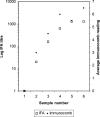Evaluation of an in-practice test for feline coronavirus antibodies
- PMID: 15123150
- PMCID: PMC7128989
- DOI: 10.1016/j.jfms.2004.01.001
Evaluation of an in-practice test for feline coronavirus antibodies
Abstract
A commercially available in-practice test for feline coronavirus (FCoV) antibodies (FCoV Immunocomb, Biogal Galed Laboratories) was evaluated by comparison with the gold standard FCoV immunofluorescent antibody (IFA) test. One hundred and three serum or plasma samples were selected and tested: 70 were positive by both tests, 24 were negative by both tests. The in-practice test produced five false positive and four false negative results. The sensitivity of the in-practice test was 95% and the specificity was 83%. When the titres were compared it was found that the in-practice test results were significantly correlated with IFA titres but the degree of correlation was not likely to be clinically useful. The IFA titres of the four false negative samples were found to be low (less than 40) which suggests that even a cat with a false negative result is still unlikely to be excreting FCoV. A negative result with the in-practice assay is likely to be reliable for screening cats prior to entry into an FCoV-free cattery or stud. It would also be useful in the investigation of suspected FIP as most cats with this condition have high IFA titres of antibodies. A strong positive result would be useful in the diagnosis of FIP (in conjunction with other biochemical and cytological testing), but positive results would be of limited value in monitoring FCoV infection in healthy cats as the antibody titre could not be reliably compared with those obtained with IFA. All positive results obtained using the in-practice kit should be confirmed and titrated by IFA. The kit also appeared to work efficiently with ascites samples (n=6) but too few samples were analysed to draw firm conclusions.
Figures





Similar articles
-
Utility of feline coronavirus antibody tests.J Feline Med Surg. 2015 Feb;17(2):152-62. doi: 10.1177/1098612X14538873. Epub 2014 Jun 25. J Feline Med Surg. 2015. PMID: 24966245 Free PMC article.
-
The relationship between the feline coronavirus antibody titre and the age, breed, gender and health status of Australian cats.Aust Vet J. 2006 Jan-Feb;84(1-2):2-7. doi: 10.1111/j.1751-0813.2006.tb13114.x. Aust Vet J. 2006. PMID: 16498826
-
Serum alpha1-acid glycoprotein (AGP) concentration in non-symptomatic cats with feline coronavirus (FCoV) infection.J Feline Med Surg. 2007 Aug;9(4):271-7. doi: 10.1016/j.jfms.2007.01.002. Epub 2007 Mar 6. J Feline Med Surg. 2007. PMID: 17344083 Free PMC article.
-
Feline coronavirus in multicat environments.Vet Clin North Am Small Anim Pract. 2011 Nov;41(6):1133-69. doi: 10.1016/j.cvsm.2011.08.004. Vet Clin North Am Small Anim Pract. 2011. PMID: 22041208 Free PMC article. Review.
-
FIV, FeLV, and FIPV: interpretation and misinterpretation of serological test results.Semin Vet Med Surg Small Anim. 1996 Aug;11(3):144-53. doi: 10.1016/s1096-2867(96)80026-0. Semin Vet Med Surg Small Anim. 1996. PMID: 8942210 Review.
Cited by
-
Samples with high virus load cause a trend toward lower signal in feline coronavirus antibody tests.J Feline Med Surg. 2013 Apr;15(4):295-9. doi: 10.1177/1098612X12467995. Epub 2012 Dec 6. J Feline Med Surg. 2013. PMID: 23220869 Free PMC article.
-
Seroprevalence study of feline coronavirus in owned and feral cats in Sydney, Australia.Aust Vet J. 2006 Mar;84(3):74-81. doi: 10.1111/j.1751-0813.2006.tb12231.x. Aust Vet J. 2006. PMID: 16555552 Free PMC article.
-
Utility of feline coronavirus antibody tests.J Feline Med Surg. 2015 Feb;17(2):152-62. doi: 10.1177/1098612X14538873. Epub 2014 Jun 25. J Feline Med Surg. 2015. PMID: 24966245 Free PMC article.
-
Development of a New Indirect ELISA Test for the Detection of Anti-Feline Coronavirus Antibodies in Cats.Vet Sci. 2025 Mar 4;12(3):245. doi: 10.3390/vetsci12030245. Vet Sci. 2025. PMID: 40266922 Free PMC article.
-
Diagnosis of Feline Infectious Peritonitis: A Review of the Current Literature.Viruses. 2019 Nov 15;11(11):1068. doi: 10.3390/v11111068. Viruses. 2019. PMID: 31731711 Free PMC article. Review.
References
-
- Addie D.D., Jarrett O. Control of feline coronavirus infection in kittens, Veterinary Record, 126, 1990, 164. - PubMed
-
- Addie D.D., Jarrett O. A study of naturally occurring feline coronavirus infection in kittens, Veterinary Record, 130, 1992, 133–137. - PubMed
-
- Addie D.D., Jarrett O. The use of a reverse transcriptase-polymerase chain reaction for monitoring the shedding of feline coronavirus by healthy cats, Veterinary Record, 148, 2001, 649–653. - PubMed
-
- Addie D.D., Ramsey I.K. The laboratory diagnosis of infectious diseases. Ramsey I.K., Tennant B. Manual of Canine and Feline Infectious Diseases, 2001, British Small Animal Veterinary Association: Gloucester, 1–17.
-
- Duthie S., Eckersall P.D., Addie D.D., Lawrence C.E., Jarrett O. Value of α1-acid glycoprotein in the diagnosis of feline infectious peritonitis, Veterinary Record, 141, 1997, 299–303. - PubMed
Publication types
MeSH terms
Substances
LinkOut - more resources
Full Text Sources
Other Literature Sources
Miscellaneous

